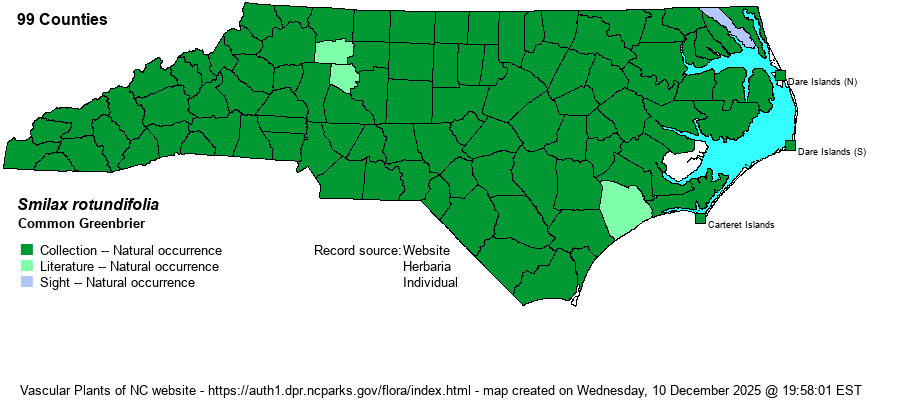| Author | L. | |
| Distribution | Statewide; certainly occurs in all 100 counties.
A wide-ranging species from ME and IL south to northern FL and central TX. It occurs in all counties of many states, especially from PA and OH south to GA and LA.
| |
| Abundance | Common to abundant, probably so in every NC county. Though Smilax glauca appears in more Carolina Vegetation Survey plots than this species, S. rotundifolia is a more obvious species to the observer as it is more robust, higher-climbing, and forms thickets that are tough to penetrate. It is essentially impossible to do field work in the state without seeing it in a given day. | |
| Habitat | Widely found in a great variety of forested habitats, especially favoring swamps, wet spots and pools in bottomland forests, and wet thickets. It also occurs in moist to even dry, second growth upland forests. Low woods that are scoured by flooding favor weedy and aggressive vines such as this species, Poison-ivy (Toxicodendron radicans), and Trumpet-creeper (Campsis radicans) over native herbs. |
| Phenology | Flowers in late April and May; fruits from September to November and persisting into winter. | |
| Identification | This is a rather high-climbing woody vine, with tardily deciduous leaves, some of which may remain on the stems into winter. It is a smooth and fairly strong vine (though not as thick as S. laurifolia) with numerous thorns scattered along the stems, and because it also grows quite thickly over other vegetation, it is very difficult to penetrate through stands of this vine; one is likely to get stabbed by the thorns, as well. The leaves are quite rotund (as the scientific name implies), generally very widely ovate with a pointed tip; the margins are entire, and the upper surface is glossy green. The blue-black berries ripen in fall. It is similar to the equally abundant S. glauca, but that species is strongly whitened below; S. rotundifolia is a medium green to light green below. Smilax hispida has somewhat similar leaves but its stems are beset with an abundance of small and narrow spines rather than thick thorns. Smilax walteri can be hard to separate from this species, but it has red berries; however, in spring and summer you may have trouble identifying these two, though S. walteri almost always grows in shallow water and is mainly found in the Coastal Plain. | |
| Taxonomic Comments | Plants of upper Piedmont and Mountains tend to have stems and branches +- square in cross-section. Botanists have attempted to recognize them as distinct, but with little agreement among colleagues.
| |
| Other Common Name(s) | Roundleaf Greenbrier, Bullbrier, Horsebrier. Roundleaf Greenbrier is an equally used names as is Common Greenbrier, and it might be a better name as it is the more descriptive one. | |
| State Rank | S5 | |
| Global Rank | G5 | |
| State Status | | |
| US Status | | |
| USACE-agcp | FAC link |
| USACE-emp | FAC link |

